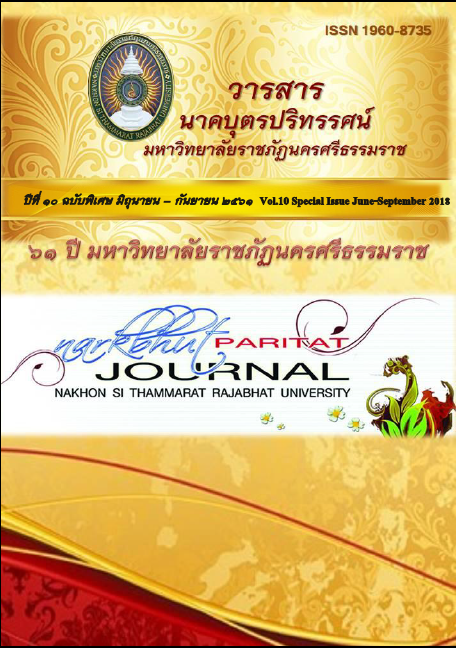กระบวนการพัฒนาเชื้อเพลิงชีวมวลภาคครัวเรือนเพื่อลดการใช้แก๊สหุงต้ม The Development Process of Household Biomass Energy for Reduction Using Cooking Gas
Main Article Content
บทคัดย่อ
บทคัดย่อ
การวิจัยครั้งนี้มีวัตถุประสงค์เพื่อ 1) เพื่อศึกษาบริบทกระบวนการพัฒนาเชื้อเพลิงชีวมวลภาคครัวเรือนเพื่อลดการใช้แก๊สหุงต้มชุมชนเศรษฐกิจพอพียง บ้านคลองเคียน ตำบลกะปาง 2) เพื่อถอดบทเรียนขยายผลสู่พื้นที่เครือข่ายกระบวนการพัฒนาเชื้อเพลิงชีวมวลภาคครัวเรือนเพื่อลดการใช้แก๊สหุงต้มชุมชนเศรษฐกิจพอพียง บ้านคลองเคียน ตำบลกะปาง
โดยการเก็บรวบรวมข้อมูลด้วยวิธีการสำรวจ การสังเกต การสัมภาษณ์แบบมีส่วนร่วมและไม่มีส่วนร่วม และการสัมมนากลุ่ม ผลการวิจัยพบว่า
- ผลการศึกษาบริบทกระบวนการพัฒนาเชื้อเพลิงชีวมวลภาคครัวเรือนเพื่อลดการใช้แก๊สหุงต้มชุมชนกะโสมเป็นพื้นที่มีต้นไม้ยืนต้นมากมาย ทั้งไม้จากต้นผลไม้ กิ่งไม้ ใบหญ้า ต้นยางพารา ไม้ป่า บางครั้งกลายเป็นขยะ มลภาวะ ซึ่งหาได้สะดวก ไม่มีค่าใช้จ่าย และยังช่วยกำจัดขยะ ซึ่งทุกครัวเรือนจึงหาวัสดุเหล่านี้มาหุงต้มใช้เป็นเชื้อเพลิงเตาชีวมวลในการปรุงอาหารที่ต้องต้ม ตุ๋น ใช้ไฟนานๆ ในการปรุงอาหาร ใช้ในการ เพื่อลดค่าใช้จ่ายในครัวเรือนและใช้เป็นเชื้อเพลิงพลังงานได้เป็นอย่างดี
- ผลการขยายผลสู่พื้นที่เครือข่ายกระบวนการพัฒนาเชื้อเพลิงชีวมวลภาคครัวเรือนเพื่อลดการใช้แก๊สหุงต้มชุมชนเศรษฐกิจพอพียง บ้านคลองเคียน ตำบลกะปาง มีผู้สนใจใฝ่รู้ และพยายามเรียนรู้เพื่อลดรายจ่ายมาก่อน เมื่อนักวิจัยนำนักวิชาการ ผู้รู้มาอธิบาย จึงเกิดความสนใจ และต้องการเรียนรู้ในรายละเอียดถึงขั้นที่สามารถนำมาใช้ประโยชน์ในชีวิตประจำวันได้ ด้วยการพยายามทดลองขนาดเล็ก และนำความรู้ ความเข้าใจที่มีอยู่มาแลกเปลี่ยนเรียนรู้เพิ่มเติมซึ่งกันและกัน และพยายามสอบถามผู้รู้ แต่ละคนจะมีความสนใจ จึงได้ร่วมมือกับทีมวิจัยที่จะไปศึกษาดูงานและกลับมาดำเนินการในครัวเรือน จึงขับเคลื่อน เคลื่อนไหวอย่างต่อเนื่อง
ข้อเสนอแนะเชิงบริหาร
- องค์กรปกครองท้องถิ่น ควรจัดพื้นที่เป้าหมายในการลดใช้แก๊สหุงต้ม ให้ใช้เตาชีวมวลอย่างจริงจัง ทั้งด้านงบประมาณ และด้านวิชาการ ในปรากฏเป็นรูปธรรมที่มีตัวชี้วัดเชิงตัวเลขที่วัดประเมินได้ชัดเจนใช้
- หน่วยงานที่ใช้แก๊สหุงต้มจำนวนมากๆ ควรพิจารณาปรับเปลี่ยนมาใช้เตาชีวมวล โดยจดรายการค่าใช้แก๊สเปรียบเทียบกับการใช้เตาชีวมวล แสดงให้เห็นส่วนต่างของค่าใช้จ่ายให้ชัดเจน
ข้อเสนอแนะเชิงวิชาการ
- ควรมีการวิจัยปฏิบัติการค้นหารูปแบบการประหยัดค่าแก๊สหุงต้มในองค์กรขนาดกลางขนาดใหญ่ เพื่อเสนอต่อผู้บริหารองค์กรพิจารณานำไปประยุกต์ใช้ต่อไป
- ควรสนับสนุนให้นักศึกษาระดับบัณฑิต วิจัยพลังงานทดแทนในรูปแบบต่างๆ ให้มากขึ้น
คำสำคัญ : เชื้อเพลิงชีวมวล ภาคครัวเรือน ลดการใช้แก๊สหุงต้ม
Article Details
ประเภทบทความ
บทความวิจัย
เอกสารอ้างอิง
กรมปศุสัตว์, “ปริมาณปศุสัตว์ในประเทศไทย”, ข้อมูลเศรษฐกิจปศุสัตว์ประจำปี 2543, หน้า 1-35.
กรมพัฒนาและส่งเสริมเชื้อเพลิง, 2543, “รายงานเชื้อเพลิงของประเทศไทย ปี 2543”, วารสารรายงานเชื้อเพลิงของประเทศไทย, ฉบับที่ 1, หน้า 2-10.
กรมพัฒนาและส่งเสริมเชื้อเพลิง, 2544, “อัตราส่วนวัสดุเหลือใช้ต่อผลผลิต แฟคเตอร์ของการใช้เป็นเชื้อเพลิงและแฟคเตอร์วัสดุเหลือใช้ที่ยังไม่มีการนำไปใช้”รายงานผลการสำรวจวัสดุเหลือใช้ทางการเกษตร.
ปัญญา เลิศไกร (2552) นวัตกรรมการปลูกปาล์มน้ำมันลุ่มน้ำปากพนัง นครศรีธรรมราช: วิทยานิพนธ์ ปรัชญาดุษฎีบัณฑิต สาขา การศึกษาเพื่อการพัฒนาท้องถิ่น มหาวิทยาลัยราชภัฏนครศรีธรรมราช
มานิตย์ อำพันธุ์, 2544, “ก๊าซชีวภาพและกระบวนการเกิด”, การอบรมการส่งเสริมก๊าซชีวภาพ ภาคเหนือ, 24 เมษายน 2544, สำนักงานส่งเสริมการเกษตรภาคเหนือ, จังหวัดเชียงใหม่,หน้า 1-43.
นิรันดร โพธิการนนท์, 2544, “มลภาวะจากน้ำเสียจากฟาร์มเลี้ยงสัตว์ขนาดกลาง”, เทคโนโลยีก๊าซ ชีวภาพเพื่อผลิตเชื้อเพลิงชีวมวลและบำบัดมลภาวะในฟาร์มเลี้ยงสัตว์, 2544 , หน้า 1-23.
สมชัย จันทร์สว่าง, 2545, “เทคโนโลยีแก๊สชีวภาพ”, เอกสารเผยแพร่เทคโนโลยีแก๊สชีวภาพ, สถาบันวิจัยและพัฒนาเทคโนโลยีแห่งมหาวิทยาลัยเกษตร, หน้า 2-38.
ศูนย์สารสนเทศการเกษตร,2544, “ปริมาณผลผลิตทางการเกษตร”, สถิติการเกษตรของประเทศไทย, กรุงเทพฯ, หน้า 12-30.
ศูนย์ส่งเสริมเชื้อเพลิงชีวมวล มูลนิธิเชื้อเพลิงเพื่อสิ่งแวดล้อม, 2545, “การใช้ประโยชน์จากก๊าซ ชีวภาพ”, บทความด้านเชื้อเพลิงชีวมวล ปี 2545, ฉบับที่ 1, หน้า 1-18.
ศูนย์ส่งเสริมเชื้อเพลิงชีวมวล มูลนิธิเชื้อเพลิงเพื่อสิ่งแวดล้อม, 2545, “ข้อมูลชีวมวลทั่วไป”, บทความด้านเชื้อเพลิงชีวมวล ปี 2545, ฉบับที่ 1, หน้า 3-42.
สมศักดิ์ เขตสมุทร, สมศักดิ์ เจนศิริศักดิ์และ บุญส่ง ศรีเจริญธรรม, 2540, “การเลี้ยงสัตว์น้ำในระบบเกษตร”, ความสำคัญของความหลากหลายทางชีวภาพในระบบเกษตร, ฉบับที่ 1, หน้า 3-22.
สำนักงานคณะกรรมการนโยบายเชื้อเพลิงแห่งชาติ, 2545, “การส่งเสริมการใช้เชื้อเพลิงจากชีวมวลของประเทศไทย”, วารสารนโยบายเชื้อเพลิง, ฉบับที่ 55, หน้า 1-30.
สำนักงานสำนักงานคณะกรรมการนโยบายเชื้อเพลิงแห่งชาติ, 2543, “เชื้อเพลิงเพื่อความเข้าใจ ใช้อย่างรู้คุณค่า พัฒนาสู่ความยั่งยืน”, พิมพ์ครั้งที่ 1, โรงพิมพ์คุรุสภา, กรุงเทพ, หน้า 2-4, 9, 11-24.
Danish International Development Assistance, 2003, “Biomass one-stop Clearing
House Energy for Environment Foundation”, Introduction to conversion of Biomass to Electricity and Thermal Energy, 17-18 March 2003, Bangkok, p. 54.
Energy Information Administration, 2001, “National Energy Education Development’s
Guidelines for Energy Education”, KIAKID Page, No. 1, pp. 1-10.
Regional Aquaculture Lead Center, 1981, “Integrated fish farming (I)”, pp. 1-55.
กรมพัฒนาและส่งเสริมเชื้อเพลิง, 2543, “รายงานเชื้อเพลิงของประเทศไทย ปี 2543”, วารสารรายงานเชื้อเพลิงของประเทศไทย, ฉบับที่ 1, หน้า 2-10.
กรมพัฒนาและส่งเสริมเชื้อเพลิง, 2544, “อัตราส่วนวัสดุเหลือใช้ต่อผลผลิต แฟคเตอร์ของการใช้เป็นเชื้อเพลิงและแฟคเตอร์วัสดุเหลือใช้ที่ยังไม่มีการนำไปใช้”รายงานผลการสำรวจวัสดุเหลือใช้ทางการเกษตร.
ปัญญา เลิศไกร (2552) นวัตกรรมการปลูกปาล์มน้ำมันลุ่มน้ำปากพนัง นครศรีธรรมราช: วิทยานิพนธ์ ปรัชญาดุษฎีบัณฑิต สาขา การศึกษาเพื่อการพัฒนาท้องถิ่น มหาวิทยาลัยราชภัฏนครศรีธรรมราช
มานิตย์ อำพันธุ์, 2544, “ก๊าซชีวภาพและกระบวนการเกิด”, การอบรมการส่งเสริมก๊าซชีวภาพ ภาคเหนือ, 24 เมษายน 2544, สำนักงานส่งเสริมการเกษตรภาคเหนือ, จังหวัดเชียงใหม่,หน้า 1-43.
นิรันดร โพธิการนนท์, 2544, “มลภาวะจากน้ำเสียจากฟาร์มเลี้ยงสัตว์ขนาดกลาง”, เทคโนโลยีก๊าซ ชีวภาพเพื่อผลิตเชื้อเพลิงชีวมวลและบำบัดมลภาวะในฟาร์มเลี้ยงสัตว์, 2544 , หน้า 1-23.
สมชัย จันทร์สว่าง, 2545, “เทคโนโลยีแก๊สชีวภาพ”, เอกสารเผยแพร่เทคโนโลยีแก๊สชีวภาพ, สถาบันวิจัยและพัฒนาเทคโนโลยีแห่งมหาวิทยาลัยเกษตร, หน้า 2-38.
ศูนย์สารสนเทศการเกษตร,2544, “ปริมาณผลผลิตทางการเกษตร”, สถิติการเกษตรของประเทศไทย, กรุงเทพฯ, หน้า 12-30.
ศูนย์ส่งเสริมเชื้อเพลิงชีวมวล มูลนิธิเชื้อเพลิงเพื่อสิ่งแวดล้อม, 2545, “การใช้ประโยชน์จากก๊าซ ชีวภาพ”, บทความด้านเชื้อเพลิงชีวมวล ปี 2545, ฉบับที่ 1, หน้า 1-18.
ศูนย์ส่งเสริมเชื้อเพลิงชีวมวล มูลนิธิเชื้อเพลิงเพื่อสิ่งแวดล้อม, 2545, “ข้อมูลชีวมวลทั่วไป”, บทความด้านเชื้อเพลิงชีวมวล ปี 2545, ฉบับที่ 1, หน้า 3-42.
สมศักดิ์ เขตสมุทร, สมศักดิ์ เจนศิริศักดิ์และ บุญส่ง ศรีเจริญธรรม, 2540, “การเลี้ยงสัตว์น้ำในระบบเกษตร”, ความสำคัญของความหลากหลายทางชีวภาพในระบบเกษตร, ฉบับที่ 1, หน้า 3-22.
สำนักงานคณะกรรมการนโยบายเชื้อเพลิงแห่งชาติ, 2545, “การส่งเสริมการใช้เชื้อเพลิงจากชีวมวลของประเทศไทย”, วารสารนโยบายเชื้อเพลิง, ฉบับที่ 55, หน้า 1-30.
สำนักงานสำนักงานคณะกรรมการนโยบายเชื้อเพลิงแห่งชาติ, 2543, “เชื้อเพลิงเพื่อความเข้าใจ ใช้อย่างรู้คุณค่า พัฒนาสู่ความยั่งยืน”, พิมพ์ครั้งที่ 1, โรงพิมพ์คุรุสภา, กรุงเทพ, หน้า 2-4, 9, 11-24.
Danish International Development Assistance, 2003, “Biomass one-stop Clearing
House Energy for Environment Foundation”, Introduction to conversion of Biomass to Electricity and Thermal Energy, 17-18 March 2003, Bangkok, p. 54.
Energy Information Administration, 2001, “National Energy Education Development’s
Guidelines for Energy Education”, KIAKID Page, No. 1, pp. 1-10.
Regional Aquaculture Lead Center, 1981, “Integrated fish farming (I)”, pp. 1-55.


